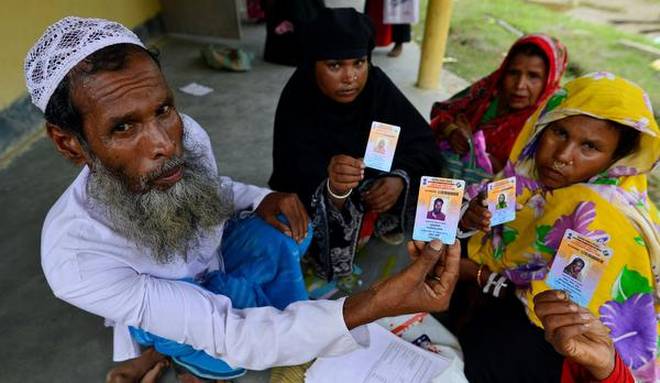By: Ravneet Kaur
Introduction
In the past the porous borders cause lot of illegal migration from various countries ,especially from Bangladesh and Myanmar to Assam. This is also because of the history of migration . During the British rule the Assam was merged with the Bengal Presidency for administrative purpose. From 1826 to 1947 ,the british continuously brought migrant workers to Assam for cheap labour in tea plantations. After British rule Two major migration came, first after the Partition in 1947 from east Pakistan .The second wave came aftermath of the liberation of Bangladesh in 1971. This lead to an agitation during 1978-1985 by the student unions .Eventually Assam accord was signed under which illegal migrants were to be identified and deported.

Need For NRC :
Assam has experienced a large influx of illegal immigrants around the time of partition and the Indo-Pak war of 1971. NRC is basically Register of Indian citizens.It tries to deal with the major problem of illegal migrants from Bangladesh to Assam.
Preparation of NRC:
In India, the NRC have been prepared twice till now, but only in Assam. There was no mention of it in the constitution of India and no mechanism for its preparation has ever been mentioned in any of constitutional provisions. However ,a register of citizens was published in 1951 by recording the particulars of all the persons enumerated during that year’s census. This unique step was necessitated by wide spread allegations of massive ,unabated illegal immigration from Bangladesh. The 1951 NRC estimated the number of migrants from Bangladesh to around 10-12% of the total population of Assam. However, there is no such record of what happened to those who were excluded from the 1951 NRC.
Incidents Leading To NRC:
Nellie and Khoirabari massacre took place in 1983 in the backdrop of tension between centre Government and AASU (All Assam Student Union) over deletion of foreigners from electoral rolls. Most of the victims were Bengali hindus and Muslim immigrants. There after the Assam movement or Assam agitation was a popular movement against illegal migrants in Assam. The movement was led by All Assam Student Union (AASU) and All Assam Gona Sangam Parishad (AAGSP). The student leaders in 1979 came out in fierce protest demanding detention ,disenfranchisement and deportation of illegal migrants from Assam.
Aftermath of Assam Agitation:
The illegal immigrants(Detention by Tribunal)Act 1983 passed by Parliament to stem the influx of immigrants( It was struck down by the Supreme court of India in 2005 in Sarbananda Sonowal Vs UOI) Talks between the Union Government and AASU-AAGSP initiated. In 1985 ,the Assam Accord was signed between the Centre, Assam Government and AASU-AAGSP to end agitation over foreigners.
Under Assam Accord :
1. Persons who came to Assam prior to 01/01/1966 ‘Shall be regularised’.
2. Persons who came to Assam between 1966-1971 must
a) Register themselves
b) have their names deleted from electoral rolls.
c) after 10 years ,have their names restored to the electoral rolls.
3. Persons who came to Assam after 24/03/1971 shall be expelled from Assam. In 1985 Amendment of citizenship Act inserted Assam Accord rules by adding section 6A to Act.
Role of Supreme Court:
In 2008, there was a PIL filed by the student union for the deletion of foreigners name in electoral rolls and updation of NRC . In 2013, the Supreme court directs Centre and the State to begin the process for updation of NRC. SC decided the it will judicially oversee the process of updating the NRC which is supposed to help identify Indian Citizens residing in Assam in accordance with the citizenship Act,1955 and Assam Accord.
How the NRC being updated:
Updation of NRC begin in 2015 . Rules were ,if anyone wants to see his name in the list of citizens of Assam then they have to submit a form with list A documents to prove his residence in the state before March 25,1971. If anybody claims that his ancestors are native residents of Assam then she/he has to submit a form with documents provided in list B.
National Population Register (NPR):
NPR is the list of ‘usual residents’ of the country. It is compulsory for every usual resident of India to register in the NPR. This include both Indian citizens as well as foreign citizens. The objective of NPR is basically to create a database of every usual resident in the country. The survey for NPR was first conducted in the year 2010. ‘Usual Resident‘ is defined for the purpose of NPR as a person who has resided in a local area for past 6 months or more or a person who intends to reside in that area for the next 6 months or more.
Legal Basis for NPR and NCR:
Section 14 A was inserted in the citizenship Act 1955 in 2004, providing for the compulsory registration of every citizen and the issue of ‘National Identity Card’. It also said that the central government may maintain a National Register of Indian citizens and for that purpose establish a National Registration Authority. National Population Register is a mechanism outlined in a set of rules framed under the citizenship act 1955. The process of preparing Nation wide NPR has been kick started with a Gazette notification of July 31, 2019. In pursuance of sub-rule (4) of rule 3 of citizenship rules,2003 ,the Central Government hereby decides to prepare and update population Register.
NPR & Census:
While the process of NPR and Census begin simultaneously, the two database are not same. The census is the largest single source of a variety of statistical information on different characteristics of the people of India, while NPR only contain demographic information. More details are required for census like information on demography,economic literacy and education and housing and household amenities The census is the basis for receiving the country’s progress in the past decades , monitoring the ongoing schemes of the government and plan for future . Census is backed by the census Act 1948.
Why NPR when we already have Census Act: Home Ministry states that NPR helps identify the current demographics of the actual Residents who will be direct beneficiaries of any schemes launched in the area.
Author: Ravneet Kaur (Panjab University,Dept of Law)
